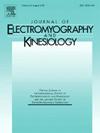High-density EMG reveals atypical spatial activation of the gastrocnemius during walking in adolescents with Cerebral Palsy
IF 2.3
4区 医学
Q3 NEUROSCIENCES
引用次数: 0
Abstract
Children with Cerebral Palsy (CP) exhibit less-selective, simplified muscle activation during gait due to injury of the developing brain. Abnormal motor unit recruitment, altered excitation-inhibition balance, and muscle morphological changes all affect the CP electromyogram. High-density surface electromyography (HDsEMG) has potential to reveal novel manifestations of CP neuromuscular pathology and functional deficits by assessing spatiotemporal details of myoelectric activity. We used HDsEMG to investigate spatial-EMG distribution and temporal-EMG complexity of gastrocnemius medialis (GM) muscle during treadmill walking in 11 adolescents with CP and 11 typically developed (TD) adolescents.
Our results reveal more-uniform spatial-EMG amplitude distribution across the GM in adolescents with CP, compared to distal emphasis in TD adolescents. More-uniform spatial-EMG was associated with stronger ankle co-contraction and spasticity. CP adolescents exhibited a non-significant trend towards elevated EMG-temporal complexity. Homogenous spatial distribution and disordered temporal evolution of myoelectric activity in CP suggests less-structured and desynchronized recruitment of GM motor units, in combination with muscle morphological changes. Using HDsEMG, we uncovered novel evidence of atypical spatiotemporal activation during gait in CP, opening paths towards deeper understanding of motor control deficits and better characterization of changes in muscular activation from interventions.
高密度肌电图显示脑瘫青少年行走时腓肠肌的非典型空间激活。
由于发育中的大脑受到损伤,脑性瘫痪(CP)儿童在步态过程中表现出选择性较低、肌肉激活简化的特点。异常的运动单位募集、兴奋-抑制平衡的改变以及肌肉形态的变化都会影响 CP 肌电图。高密度表面肌电图(HDsEMG)可通过评估肌电活动的时空细节,揭示 CP 神经肌肉病理和功能障碍的新表现。我们使用 HDsEMG 研究了 11 名患有 CP 的青少年和 11 名发育正常(TD)的青少年在跑步机行走过程中腓肠肌内侧(GM)肌肉的空间-EMG 分布和时间-EMG 复杂性。我们的研究结果表明,与 TD 青少年的远端重点相比,CP 青少年腓肠肌的空间-EMG 振幅分布更加均匀。更均匀的空间-EMG 与更强的踝关节共收缩和痉挛有关。CP青少年的EMG-时间复杂性呈上升趋势,但不明显。脊髓灰质炎患者肌电活动的均匀空间分布和无序时间演变表明,结合肌肉形态学变化,GM 运动单元的招募缺乏结构性和非同步性。通过使用 HDsEMG,我们发现了 CP 患者步态期间非典型时空激活的新证据,为深入了解运动控制缺陷和更好地描述干预措施引起的肌肉激活变化开辟了道路。
本文章由计算机程序翻译,如有差异,请以英文原文为准。
求助全文
约1分钟内获得全文
求助全文
来源期刊
CiteScore
4.70
自引率
8.00%
发文量
70
审稿时长
74 days
期刊介绍:
Journal of Electromyography & Kinesiology is the primary source for outstanding original articles on the study of human movement from muscle contraction via its motor units and sensory system to integrated motion through mechanical and electrical detection techniques.
As the official publication of the International Society of Electrophysiology and Kinesiology, the journal is dedicated to publishing the best work in all areas of electromyography and kinesiology, including: control of movement, muscle fatigue, muscle and nerve properties, joint biomechanics and electrical stimulation. Applications in rehabilitation, sports & exercise, motion analysis, ergonomics, alternative & complimentary medicine, measures of human performance and technical articles on electromyographic signal processing are welcome.

 求助内容:
求助内容: 应助结果提醒方式:
应助结果提醒方式:


